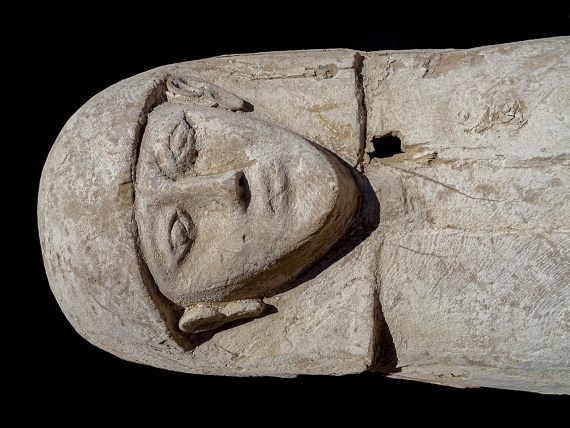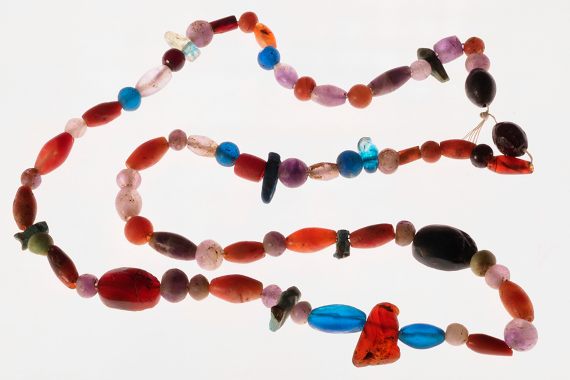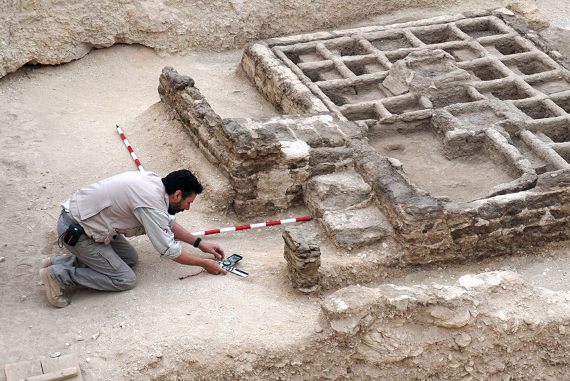The Djehuty Project has shed much light on the reign of one of the few female pharaohs in history. The latest findings at the archaeological site reveal many details about Egyptian craftsmanship and life in ancient Thebes.
Necropolis of Dra Abu el-Naga in Thebes (present-day Luxor, Egypt). 3,600 years ago. A young girl about 15 or 16 years old is buried in a wooden coffin painted white. She wears two earrings in her left ear and two rings, one on each hand of her mummified body. Four necklaces rest on her chest. One of them hides a mystery. Welcome to Ancient Egypt.
Beneath the merciless Sun on the western bank of the Nile, just before reaching the majestic Valley of the Kings, a group of Spanish archaeologists reconstruct this and other stories from the past by excavating a portion of the necropolis. The site revolves around the tomb of Djehuty, supervisor of the Treasury and high court dignitary of the powerful Queen Hatshepsut, one of the few women who reigned as pharaoh in ancient Egypt, between 1500 and 1450 BCE. But the project has long since surpassed the figure of Djehuty, “who was surely somewhat corrupt and a bit of a thief, but also an intellectual preoccupied with writing,” says José Manuel Galán, who has been directing the excavations for almost 20 years.

It might be a cliché to remark that our concept of the world of Ancient Egypt has been covered up like the sand blankets the desert, but the reality of these investigations confirms that it is easy to feel overwhelmed in Egypt. This is how Galán, a researcher at the Institute of Languages and Cultures of the Mediterranean and the Middle East of the CSIC (Spain) describes it: “The amount of material and the state of conservation that you find when you excavate surpasses everything: we found a stuccoed wooden tablet that a student used 3,500 years ago to learn to write, bows that still have the bowstring tied at one end, mummies, coffins, bouquets of flowers, mathematical papyruses… In 2017 we found a garden and, luckily, thanks to the dryness of the land, the seeds that were planted 4,000 years ago are preserved. The painted or sculpted tombs, the sculpture, the architecture, the religion, the science… In every cultural facet of the human being, Egypt leaves you stunned.“
The oldest blue glass beads in the Egyptian world
One of the surprises from the most recent campaign of Project Djehuty, which ended in February 2020, is the mysterious necklace from the mummy of the young girl. It consists of 74 pieces carved in amethyst, cornelian and amber and with a hawk representing the god Horus between two scarabs—the famous beetle-shaped amulets. Researchers were surprised by the richness of the trousseau for such a young person with a relatively modest coffin. They were even more intrigued by certain beads in the necklace, which were deep blue, like the sea.

“They look like pieces of blue glass which from a scientific point of view is very interesting. This material is an import that comes from Syria to Egypt and supposedly does not start to be used until about 100 years after the time of this coffin. That is, with this discovery we may have the oldest blue glass beads in the Egyptian world. To confirm this and rule out blue quartz, we have to do some analysis, for which we have partnered with the French Institute of Archaeology in Cairo,” says José Manuel Galán.

The mystery of the necklace highlights two circumstances in modern Egyptology. First, no piece can leave the country, even under the noble objective of research, so researchers need portable equipment on site. Second, the analysis of sites is increasingly linked to analytical science. “If you don’t have technological equipment, which is also complicated because customs won’t let you bring it into the country, or unless you partner with a national or foreign institution that is in Egypt, there are a lot of things you can’t do,” the Egyptologist explains.
Chemists, palaeopathologists and palaeobotanists
Thus, when the Project Djehuty team meets during the six weeks a year they dig in Egypt, a Renaissance spirit floats in the air. The team of 35 researchers includes archaeologists, historians, architects and restorers —professions that may seem obvious— but also chemists, who analyse the inks with which the ancient Egyptians wrote, painted or dyed fabrics; palaeopathologists, who investigate the beings that once inhabited the mummies and the circumstances of their deaths; and palaeobotanists, who study seeds or pollen, the remains of an environment from 4,000 years ago.
On one occasion they tried to study the DNA of the many falcon mummies they have found to compare it with that of current species, but anything to do with DNA does not sit well with the Egyptian authorities. “It’s a shame because when you find a group of mummies you would like to know what family relationship they have with each other and there’s nothing there,” laments Galán.

Since adventure is a must in Egypt, one of the team’s doctors managed to import a portable CAT scanner with which they x-rayed the mummies, including the girl with the necklace discovered during this campaign. They also scanned the entire site in collaboration with Leica Geosystems and used an ultrasound machine to remove the mud that had been encrusted on the walls of Djehuty’s tomb for thousands of years. In this campaign they have installed a replica of the garden made from fiberglass by Factum Arte, the company that made the copy of Tutankhamun’s tomb. “Now our great challenge, from the technological point of view, is to transfer all the information from the excavation to a geo-referenced database and make it freely accessible on the Internet.”
A Sistine Chapel on the banks of the Nile
Regarding Djehuty himself, for whom this ambitious project is named, neither his coffin nor his mummy —probably stolen by tomb robbers— have been found yet, but his burial chamber has been identified, painted with writings and drawings from the Book of the Dead, a text intended to help the deceased on their way to the afterlife, a reflection of his passion for writing and script. This is truly a Sistine Chapel on the banks of the Nile.

In addition, outside, buried under a false floor in the courtyard, three coffins from different periods have been found: the “White Lady”, a coffin from the year 1000 BCE of an unknown woman, painted completely white and now on display in the Cairo Museum; Iqer the Archer, a Nubian warrior who was buried 4,000 years ago with his bows and arrows, which now rest in the Luxor Museum; and Neb, hidden in a Rishi (winged) funerary coffin from 1600 BCE, painted in bright colours and adorned with a feather design.
Iqer, Neb and the White Lady are now joined by the unknown girl with the mysterious necklace.
Comments on this publication